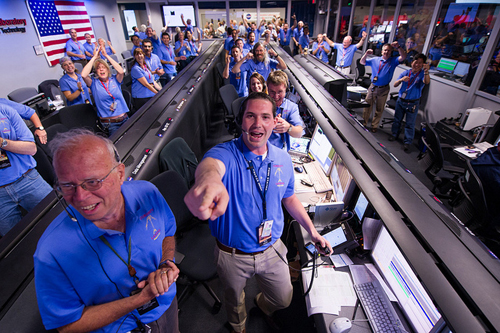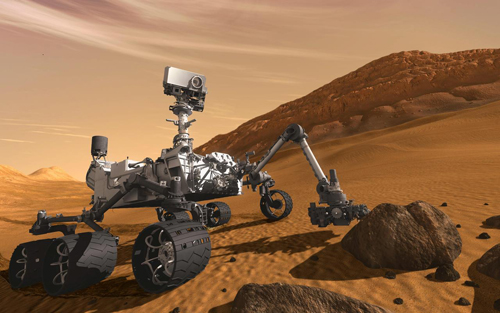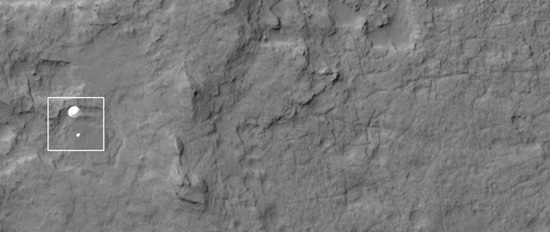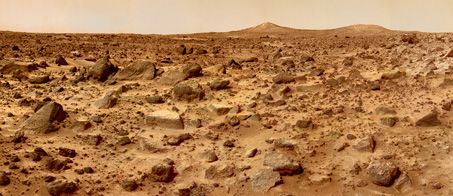As noted in yesterday’s post, Curiosity, piloted by NASA engineers, has successfully landed on the surface of Mars. The rover’s two-year mission is to investigate whether conditions on Mars are favorable for microbial life and to seek clues in Martian rocks about possible past life on and beneath the surface of the planet.
Launched from Earth on November 16, 2011, the robotic lab sailed through space for more than eight months, covering 352 million miles (566 million km). It pierced Mars’ atmosphere at 13,000 miles per hour, which is 17 times the speed of sound. A complex process involving a supersonic parachute, sky crane, retro-rockets, and retracting cables was employed to slow descent and then lower Curiosity onto Martian soil. The rover came to rest near the foot of a huge mountain (three miles tall and 96 miles in diameter) inside Gale Crater.
About the size of a car and weighing more than a ton, Curiosity has six wheels, 17 cameras, and 10 sophisticated scientific instruments. All in, it’s more than 15 times larger than its predecessor Mars rovers, Spirit and Opportunity. Some of the Curiosity‘s scientific tools are the first of their kind on Mars, such as a laser-firing instrument for checking rocks’ elemental composition from a distance.
NASA plans to put Curiosity and its various instruments through several weeks of engineering checks before driving it beyond the landing site. Once certified fit to ramble, Curiosity will be able to move at a rate of approximately 660 feet (200 meters) per day on Martian terrain. It will stop here and there to drill into rock, scoop soil, and feed samples into particular laboratory instruments inside itself, and it will transmit data and photos back to Earth.
Curiosity is important for several reasons. It’s the first astrobiology mission of any sort since the 1970s, as well as the first rover designed to search for life on Mars. In terms of size and weight, the vehicle is huge by comparison with prior probes, and its successful landing demonstrates the feasibility of delivering heavier loads to the Martian surface, paving the way for eventual manned Mars missions. (As Ambassador Bleich noted yesterday, the President has challenged NASA to land humans on Mars by 2025.)
NASA’s long-term Mars program is a science-driven enterprise that seeks to determine whether Mars was, is, or can become a habitable world. The four key goals are to understand the climate of Mars, understand the geology of Mars, determine whether life of any sort ever existed on Mars, and to prepare the way for in-person human exploration.
My friends at NASA say that Mars seems strangely familiar (with polar ice caps, clouds, and seasonal weather patterns) yet different enough to challenge our perceptions of what makes a planet work. New discoveries regularly shake up their understanding and send them back to the drawing board to revise existing theories. Most tantalizing are hints that the seemingly sterile Martian wasteland once raged with volcanoes, thunder storms, flash floods, and ocean tides.
NASA has been studying Mars for a long time. Our first close-up picture of the red planet was snapped almost 50 years ago, in 1965. Fly-by and orbiter missions have regularly photographed and mapped the planet from above. And then, on July 4, 1997, Sojourner rover successfully landed on the surface and explored Mars for approximately three months before communications contact was lost. It was Sojourner whose findings suggested that Mars may once have had liquid water on its surface and a thicker atmosphere.
In January of 2004 twin rovers Spirit and Opportunity landed on different sides of the planet. Those two rovers focused on investigating Mars’ environmental history by examining geological formations. Both were highly successful and functioned long after their expected lifetimes. Spirit operated until communications were lost in March 2010, and Opportunity still continues to send back valuable information.

This gives you a sense of the evolution of rovers in size and complexity. Clockwise from lower left: Sojourner, Opportunity, humans, Curiosity.
So, what’s next? The Mars Atmosphere and Volatile Evolution Mission, or MAVEN, is scheduled to launch in 2013. Selected from 26 competitive proposals in 2007, MAVEN will explore the planet’s upper atmosphere, ionosphere, and interactions with the sun and solar wind.
Basically, the mission will try to determine what might have happened to Mars’ ancient water. More technically, scientists will use MAVEN data to determine the role that loss of volatile compounds (such as carbon dioxide and water) from the Mars atmosphere to space has played over time, which in turn will provide insight into the history of the planet’s atmosphere, climate, and prior and future habitability.
In addition, NASA is considering a robotic surface mission for later this decade that would focus in part on improving and testing technologies necessary to facilitate direct human exploration of Mars. The effort is part of NASA’s ongoing outreach to and collaboration with international and private-sector partners.
In response to NASA’s solicitation of outside ideas, more than 400 concepts and abstracts were presented at a public conference in June at the Lunar and Planetary Institute in Houston. The Institute will submit to NASA later this summer a report on the best of those ideas, which will help NASA plan, calibrate, and sequence future steps in the Mars Exploration Program.
So, there’s lots of excitement ahead. For now, though, I’m just happy to celebrate the safe arrival of Curiosity. In due course I look forward to seeing the rover pass its post-landing systems checks and sally forth across the Martian landscape.
I’ll tweet and blog from time to time as new data or particularly interesting photographs are sent back to Earth from Mars. If you are interested in seeing the full version of the above video of Curiosity’s landing, click here.
![]()
 RSS
RSS










 View my Profile
View my Profile Connect with Wellington
Connect with Wellington Watch our Videos & Subscribe
Watch our Videos & Subscribe Watch our Videos on Vimeo
Watch our Videos on Vimeo Connect on GPlus
Connect on GPlus US Embassy NZ
US Embassy NZ


 Post Entries (RSS)
Post Entries (RSS)

